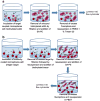Llama-derived single-domain antibodies for the detection of botulinum A neurotoxin
- PMID: 20582697
- PMCID: PMC3049303
- DOI: 10.1007/s00216-010-3905-3
Llama-derived single-domain antibodies for the detection of botulinum A neurotoxin
Abstract
Single-domain antibodies (sdAb) specific for botulinum neurotoxin serotype A (BoNT A) were selected from an immune llama phage display library derived from a llama that was immunized with BoNT A toxoid. The constructed phage library was panned using two methods: panning on plates coated with BoNT A toxoid (BoNT A Td) and BoNT A complex toxoid (BoNT Ac Td) and panning on microspheres coupled to BoNT A Td and BoNT A toxin (BoNT A Tx). Both panning methods selected for binders that had identical sequences, suggesting that panning on toxoided material may be as effective as panning on bead-immobilized toxin for isolating specific binders. All of the isolated binders tested were observed to recognize bead-immobilized BoNT A Tx in direct binding assays, and showed very little cross-reactivity towards other BoNT serotypes and unrelated protein. Sandwich assays that incorporated selected sdAb as capture and tracer elements demonstrated that all of the sdAb were able to recognize soluble ("live") BoNT A Tx and BoNT Ac Tx with virtually no cross-reactivity with other BoNT serotypes. The isolated sdAb did not exhibit the high degree of thermal stability often associated with these reagents; after the first heating cycle most of the binding activity was lost, but the portion of the protein that did refold and recover antigen-binding activity showed only minimal loss on subsequent heating and cooling cycles. The binding kinetics of selected binders, assessed by both an equilibrium fluid array assay as well as surface plasmon resonance (SPR) using toxoided material, gave dissociation constants (K(D)) in the range 2.2 x 10(-11) to 1.6 x 10(-10) M. These high-affinity binders may prove beneficial to the development of recombinant reagents for the rapid detection of BoNT A, particularly in field screening and monitoring applications.
Figures







Similar articles
-
Llama single domain antibodies specific for the 7 botulinum neurotoxin serotypes as heptaplex immunoreagents.PLoS One. 2010 Jan 21;5(1):e8818. doi: 10.1371/journal.pone.0008818. PLoS One. 2010. PMID: 20098614 Free PMC article.
-
Thermostable llama single domain antibodies for detection of botulinum A neurotoxin complex.Anal Chem. 2008 Nov 15;80(22):8583-91. doi: 10.1021/ac8014774. Epub 2008 Oct 24. Anal Chem. 2008. PMID: 18947189 Free PMC article.
-
Evaluation of anti-botulinum neurotoxin single domain antibodies with additional optimization for improved production and stability.Toxicon. 2017 Sep 1;135:51-58. doi: 10.1016/j.toxicon.2017.06.002. Epub 2017 Jun 3. Toxicon. 2017. PMID: 28587791
-
The European AntibotABE Framework Program and Its Update: Development of Innovative Botulinum Antibodies.Toxins (Basel). 2017 Oct 2;9(10):309. doi: 10.3390/toxins9100309. Toxins (Basel). 2017. PMID: 28974033 Free PMC article. Review.
-
Mode of action of botulinum neurotoxins: current vaccination strategies and molecular immune recognition.Crit Rev Immunol. 2010;30(2):167-87. doi: 10.1615/critrevimmunol.v30.i2.50. Crit Rev Immunol. 2010. PMID: 20370628 Review.
Cited by
-
Single-Domain Antibody Multimers for Detection of Botulinum Neurotoxin Serotypes C, D, and Their Mosaics in Endopep-MS.Toxins (Basel). 2023 Sep 17;15(9):573. doi: 10.3390/toxins15090573. Toxins (Basel). 2023. PMID: 37755999 Free PMC article.
-
Surface Acoustic Wave Immunosensor for Detection of Botulinum Neurotoxin.Sensors (Basel). 2023 Sep 6;23(18):7688. doi: 10.3390/s23187688. Sensors (Basel). 2023. PMID: 37765744 Free PMC article.
-
In vivo neutralization of botulinum neurotoxins serotype E with heavy-chain camelid antibodies (VHH).Mol Biotechnol. 2013 Oct;55(2):159-67. doi: 10.1007/s12033-013-9669-1. Mol Biotechnol. 2013. PMID: 23666874
-
Isolation of a highly thermal stable lama single domain antibody specific for Staphylococcus aureus enterotoxin B.BMC Biotechnol. 2011 Sep 21;11:86. doi: 10.1186/1472-6750-11-86. BMC Biotechnol. 2011. PMID: 21933444 Free PMC article.
-
Centrifugal microfluidic platform for ultrasensitive detection of botulinum toxin.Anal Chem. 2015 Jan 20;87(2):922-8. doi: 10.1021/ac504054u. Epub 2015 Jan 5. Anal Chem. 2015. PMID: 25521812 Free PMC article.
References
-
- Montecucco C, Molgo J. Botulinal neurotoxins: revival of an old killer. Curr Opin Pharmacol. 2005;5(3):274–279. - PubMed
-
- Arnon SS, Schechter R, Inglesby TV, Henderson DA, Bartlett JG, Ascher MS, Eitzen E, Fine AD, Hauer J, Layton M, Lillibridge S, Osterholm MT, O'Toole T, Parker G, Perl TM, Russell PK, Swerdlow DL, Tonat K, Biodefense WGC. Botulinum toxin as a biological weapon—medical and public health management. JAMA. 2001;285(8):1059–1070. - PubMed
-
- Woodruff BA, Griffin PM, Mccroskey LM, Smart JF, Wainwright RB, Bryant RG, Hutwagner LC, Hatheway CL. Clinical and laboratory comparison of botulism from toxin type A, type B, and type E in the United States, 1975–1988. J Infect Dis. 1992;166(6):1281–1286. - PubMed
-
- Sharma SK, Whiting RC. Methods for detection of Clostridium botulinum toxin in foods. J Food Prot. 2005;68(6):1256–1263. - PubMed
Publication types
MeSH terms
Substances
Grants and funding
LinkOut - more resources
Full Text Sources

